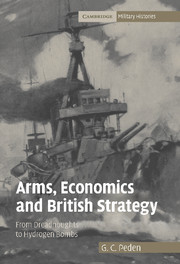Book contents
- Frontmatter
- Contents
- List of tables
- Acknowledgements
- List of abbreviations
- Introduction
- 1 The dreadnought era, 1904–1914
- 2 The First World War
- 3 Retrenchment and rearmament, 1919–1939
- 4 The Second World War
- 5 The impacts of the atomic bomb and the Cold War, 1945–1954
- 6 The hydrogen bomb, the economy and decolonisation, 1954–1969
- Conclusion
- Select bibliography
- Index
3 - Retrenchment and rearmament, 1919–1939
Published online by Cambridge University Press: 16 July 2009
- Frontmatter
- Contents
- List of tables
- Acknowledgements
- List of abbreviations
- Introduction
- 1 The dreadnought era, 1904–1914
- 2 The First World War
- 3 Retrenchment and rearmament, 1919–1939
- 4 The Second World War
- 5 The impacts of the atomic bomb and the Cold War, 1945–1954
- 6 The hydrogen bomb, the economy and decolonisation, 1954–1969
- Conclusion
- Select bibliography
- Index
Summary
Introduction
British defence policy in the inter-war years may be divided into two phases: 1919 to 1932, when economic problems and the absence of pressing dangers to national security led to reductions in the armed forces; and 1932 to 1939, when the darkening international situation gave defence preparedness increasing political priority. However, many of the strategic problems encountered during the later 1930s were rooted in the earlier phase, and this chapter analyses the period 1919–39 as a whole. There is a danger in this approach, since policies in the 1920s may be judged unfairly in the light of later events, but that is true even of the 1930s, when British defence policy was designed to deter aggression over an indefinite period even if the Chiefs of Staff were planning from 1934 on the basis of being ready for war by 1939.
In August 1919 the Cabinet decided that the defence departments should revise their estimates of expenditure for the coming year on the assumption that ‘the British Empire will not be engaged in any great war during the next ten years, and that no Expeditionary Force is required for this purpose’. The purpose of this ‘Ten Year Rule’, as it came to be called, was to assist the chancellor of the exchequer in securing the cuts in expenditure required to balance his budget and, in one form or another, the rule remained the guiding principle of defence policy until 1932.
- Type
- Chapter
- Information
- Arms, Economics and British StrategyFrom Dreadnoughts to Hydrogen Bombs, pp. 98 - 163Publisher: Cambridge University PressPrint publication year: 2007



